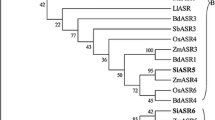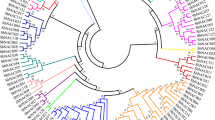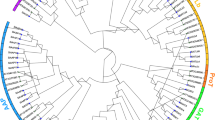Abstract
SNARE (soluble-N-ethylmaleimide-sensitive-factor accessory-protein receptor) proteins are important for plant growth and development. Based on their role in membrane fusion, SNARE proteins are involved in abiotic stress resistance. Foxtail millet (Setaria italica) is a widely cultivated crop in Asia with high tolerance to drought stress. The investigation focuses on drought stress-related genes like SNARE will help to reveal the mechanism of foxtail millet drought tolerance. In this study, we identified 52 SiSNARE genes in foxtail millet. Phylogenetic analysis, prediction of conserved motif, and gene structure analysis classified these genes into different groups, including 15 Qa-SiSNARE genes, 10 Qb-SiSNARE genes, 9 Qc-SiSNARE genes, 3 Qb + c-SiSNARE genes, and 15 R-SiSNARE genes. In silico transcript level analysis showed some SiSNAREs were tissue or development stage-specific expressed. Two cultivars of foxtail millet, “Jingu21” and “Longgu16”, showed different phenotypes under drought stress. We detected the expression of 52 SiSNARE genes in these two cultivars under drought stress. There were 15 SiSNARE genes up-regulated and 3 genes down-regulated after drought stress in both two cultivars. We also found 6 SiSNARE genes were specifically altered under stress in cultivar “Jingu21”, which showed better drought tolerance. Our results provide genomic information for SiSNARE genes in foxtail millet. Analysis of stress-related gene expression in cultivars with different phenotypes suggests some SiSNARE genes' role in drought stress response. These findings laid a foundation for further SNARE related drought stress research in foxtail millet.







Similar content being viewed by others
Data availability
The data and materials generated and/or analyzed during the current study are available from the corresponding author on reasonable request.
Code availability
Not applicable.
References
Abe H, Yamaguchi-Shinozaki K, Urao T, Iwasaki T, Hosokawa D, Shinozaki K (1997) Role of Arabidopsis MYC and MYB homologs in drought- and abscisic acid-regulated gene expression. Plant Cell 9:1859–1868
Aguilar ML, Espadas FL, Coello J, Maust BE, Trejo C, Robert ML, Santamaría JM (2000) The role of abscisic acid in controlling leaf water loss, survival and growth of micropropagated Tagetes erecta plants when transferred directly to the field. J Exp Bot 51:1861–1866
Alison Dunn M, White AJ, Vural S, Hughes MA (1998) Identification of promoter elements in a low-temperature-responsive gene (blt4.9) from barley (Hordeum vulgare L.). Plant Mol Biol 38:551–564
Andag U, Schmitt HD (2003) Dsl1p, an essential component of the golgi-endoplasmic reticulum retrieval system in yeast, uses the same sequence motif to interact with different subunits of the COPI vesicle coat. J Biol Chem 278:51722–51734
Bailey TL, Boden M, Buske FA, Frith M, Grant CE, Clementi L, Ren J, Li WW, Noble WS (2009) MEME Suite: Tools for motif discovery and searching. Nucleic Acids Res 37:202–208
Bao YM, Sun SJ, Li M, Li L, Cao WL, Luo J, Tang HJ, Huang J, Wang ZF, Wang JF, Zhang HS (2012) Overexpression of the Qc-SNARE gene OsSYP71 enhances tolerance to oxidative stress and resistance to rice blast in rice (Oryza sativa L.). Gene 504:238–244
Bassham DC, Blatt MR (2008) SNAREs: cogs and coordinators in signaling and development. Plant Physiol 147:1504–1515
Bennetzen JL et al (2012) Reference genome sequence of the model plant Setaria. Nat Biotechnol 30:555–561
Chen C, Chen H, Zhang Y, Thomas HR, Frank MH, He Y, Xia R (2020) TBtools: An integrative toolkit developed for interactive analyses of big biological data. Mol Plant 13:1194–1202
de Araujo Rufino C, Fernandes-Vieira J, Martín-Gil J, de Souza Abreu Júnior, J., Tavares, L.C., Fernandes-Correa, M., and Martín-Ramos, P. (2018) Water stress influence on the vegetative period yield components of different maize genotypes. Agronomy 8:1–9
Fasshauer D, Sutton RB, Brunger AT, Jahn R (1998) Conserved structural features of the synaptic fusion complex: SNARE proteins reclassified as Q- and R-SNAREs. Proc Natl Acad Sci U S A 95:15781–15786
Feng ZJ, He GH, Zheng WJ, Lu PP, Chen M, Gong YM, Ma YZ, Xu ZS (2015) Foxtail millet NF-Y families: Genome-wide survey and evolution analyses identified two functional genes important in abiotic stresses. Front Plant Sci 6:1–19
Finn RD et al (2014) Pfam: The protein families database. Nucleic Acids Res 42:222–230
Frank G, Pressman E, Ophir R, Althan L, Shaked R, Freedman M, Shen S, Firon N (2009) Transcriptional profiling of maturing tomato (Solanum lycopersicum L.) microspores reveals the involvement of heat shock proteins, ROS scavengers, hormones, and sugars in the heat stress response. J Exp Bot 60:3891–3908
Fujimoto SY, Ohta M, Usui A, Shinshi H, Ohme-Takagi M (2000) Arabidopsis ethylene-responsive element binding factors act as transcriptional activators or repressors of GCC box-mediated gene expression. Plant Cell 12:393–404
Gasteiger, E., Hoogland, C., Gattiker, A., Duvaud, S., Wilkins, M.R., Appel, R.D., and Bairoch, A. (2005). Protein Identification and Analysis Tools on the ExPASy Server. In The Proteomics Protocols Handbook, J.M. Walker, ed (Humana Press), pp. 571–608.
Goldsbrough AP, Albrecht H, Stratford R (1993) Salicylic acid-inducible binding of a tobacco nuclear protein to a 10 bp sequence which is highly conserved amongst stress-inducible genes. Plant J 3:563–571
Goodstein DM, Shu S, Howson R, Neupane R, Hayes RD, Fazo J, Mitros T, Dirks W, Hellsten U, Putnam N, Rokhsar DS (2012) Phytozome: A comparative platform for green plant genomics. Nucleic Acids Res 40:1178–1186
Goron TL, Raizada MN (2015) Genetic diversity and genomic resources available for the small millet crops to accelerate a New Green Revolution. Front Plant Sci 6:157
Grefen, C., Karnik, R., Larson, E., Lefoulon, C., Wang, Y., Waghmare, S., Zhang, B., Hills, A., and Blatt, M.R. (2015). A vesicle-trafficking protein commandeers Kv channel voltage sensors for voltage-dependent secretion. Nat. Plants 1.
Hachez C, Laloux T, Reinhardt H, Cavez D, Degand H, Grefen C, De Rycke R, Inzé D, Blatt MR, Russinova E, Chaumont F (2014) Arabidopsis SNAREs SYP61 and SYP121 coordinate the trafficking of plasma membrane aquaporin PIP2;7 to modulate the cell membrane water permeability. Plant Cell 26:3132–3147
He L, Zhang B, Wang X, Li H, Han Y (2015) Foxtail millet: Nutritional and eating quality, and prospects for genetic improvement. Front Agric Sci Eng 2:124–133
Heese M, Gansel X, Sticher L, Wick P, Grebe M, Granier F, Jürgens G (2001) Functional characterization of the KNOLLE-interacting t-SNARE AtSNAP33 and its role in plant cytokinesis. J Cell Biol 155:239–249
Hobo T, Asada M, Kowyama Y, Hattori T (1999) ACGT-containing abscisic acid response element (ABRE) and coupling element 3 (CE3) are functionally equivalent. Plant J 19:679–689
Hong W (2005) SNAREs and traffic. Biochim Biophys Acta 1744:493–517
Honsbein A, Sokolovski S, Grefen C, Campanoni P, Pratelli R, Paneque M, Chen Z, Johansson I, Blatt MR (2009) A tripartite SNARE-K+ channel complex mediates in channel-dependent K+ nutrition in Arabidopsis. Plant Cell 21:2859–2877
Honsbein A, Blatt MR, Grefen C (2011) A molecular framework for coupling cellular volume and osmotic solute transport control. J Exp Bot 62:2363–2370
Hu B, Jin J, Guo AY, Zhang H, Luo J, Gao G (2015) GSDS 2.0: An upgraded gene feature visualization server. Bioinformatics 31:1296–1297
Jiang C, Li X, Zou J, Ren J, Jin C, Zhang H, Yu H, Jin H (2021) Comparative transcriptome analysis of genes involved in the drought stress response of two peanut (Arachis hypogaea L.) varieties. BMC Plant Biol 21:1–14
Jones DT, Taylor WR, Thornton JM (1992) The rapid generation of mutation data matrices from protein sequences. Bioinformatics 8:275–282
Kanazawa T et al (2016) SNARE molecules in Marchantia polymorpha: Unique and conserved features of the membrane fusion machinery. Plant Cell Physiol 57:307–324
Klotz KL, Lagrimini LM (1996) Phytohormone control of the tobacco anionic peroxidase promoter. Plant Mol Biol 31:565–573
Kumar S, Stecher G, Tamura K (2016) MEGA7: molecular evolutionary genetics analysis version 7.0 for bigger datasets. Mol Biol Evol 33:1870–1874
Lata C, Sahu PP, Prasad M (2010) Comparative transcriptome analysis of differentially expressed genes in foxtail millet (Setaria italica L.) during dehydration stress. Biochem Biophys Res Commun 393:720–727
Lescot M, Déhais P, Thijs G, Marchal K, Moreau Y, Van De Peer Y, Rouzé P, Rombauts S (2002) PlantCARE, a database of plant cis-acting regulatory elements and a portal to tools for in silico analysis of promoter sequences. Nucleic Acids Res 30:325–327
Leshem Y, Melamed-Book N, Cagnac O, Ronen G, Nishri Y, Solomon M, Cohen G, Levine A (2006) Suppression of Arabidopsis vesicle-SNARE expression inhibited fusion of H2O2-containing vesicles with tonoplast and increased salt tolerance. Proc Natl Acad Sci U S A 103:18008–18013
Leshem Y, Golani Y, Kaye Y, Levine A (2010) Reduced expression of the v-SNAREs AtVAMP71/AtVAMP7C gene family in Arabidopsis reduces drought tolerance by suppression of abscisic acid-dependent stomatal closure. J Exp Bot 61:2615–2622
Li B, Li Y, Liu F, Tan X, Rui Q, Tong Y, Qiao L, Gao R, Li G, Shi R, Li Y, Bao Y (2019) Overexpressed tomosyn binds syntaxins and blocks secretion during pollen development. Plant Physiol 181:1114–1126
Li R, Han Y, Zhang Q, Chang G, Han Y, Li X, Zhang B (2020) Transcriptome profiling analysis reveals co-regulation of hormone pathways in foxtail millet during sclerospora graminicola infection. Int J Mol Sci 21:1226
Lipka V, Kwon C, Panstruga R (2007) SNARE-ware: The role of SNARE-domain proteins in plant biology. Annu Rev Cell Dev Biol 23:147–174
Livak KJ, Schmittgen TD (2001) Analysis of relative gene expression data using real-time quantitative PCR and the 2-ΔΔCT method. Methods 25:402–408
Lukowitz W, Mayer U, Jürgens G (1996) Cytokinesis in the Arabidopsis embryo involves the syntaxin-related KNOLLE gene product. Cell 84:61–71
Menkens AE, Schindler U, Cashmore AR (1995) The G-box: a ubiquitous regulatory DNA element in plants bound by the GBF family of bZIP proteins. Trends Biochem Sci 20:506–510
Nisa Z, un, Mallano, A.I., Yu, Y., Chen, C., Duan, X., Amanullah, S., Kousar, A., Baloch, A.W., Sun, X., Tabys, D., and Zhu, Y. (2017) GsSNAP33, a novel Glycine soja SNAP25-type protein gene: Improvement of plant salt and drought tolerances in transgenic Arabidopsis thaliana. Plant Physiol Biochem 119:9–20
Peng R, Zhang B (2020) Foxtail millet: A new model for C4 plants. Trends Plant Sci 26:191–201
Qi X, Xie S, Liu Y, Yi F, Yu J (2013) Genome-wide annotation of genes and noncoding RNAs of foxtail millet in response to simulated drought stress by deep sequencing. Plant Mol Biol 83:459–473
Saitou N, Nei M (1987) The neighbor-joining method: a new method for reconstructing phylogenetic trees. Mol Biol Evol 4:406–425
Salinas-Cornejo, J., Madrid-Espinoza, J., and Ruiz-Lara, S. (2019). Identification and transcriptional analysis of SNARE vesicle fusion regulators in tomato (Solanum lycopersicum) during plant development and a comparative analysis of the response to salt stress with wild relatives. J. Plant Physiol. 242.
Singh RK, Shweta S, Muthamilarasan M, Rani R, Prasad M (2019) Study on aquaporins of Setaria italica suggests the involvement of SiPIP3;1 and SiSIP1;1 in abiotic stress response. Funct Integr Genomics 19:587–596
Slane D, Reichardt I, El Kasmi F, Bayer M, Jürgens G (2017) Evolutionarily diverse SYP1 Qa-SNAREs jointly sustain pollen tube growth in Arabidopsis. Plant J 92:375–385
Südhof TC, Rothman JE (2009) Membrane fusion: Grappling with SNARE and SM proteins. Science (80- ) 323:474–477
Tuskan GA et al (2006) The genome of black cottonwood, Populus trichocarpa (Torr & Gray). Science (80- ) 313:1596–1604
Uemura T, Ueda T, Ohniwa RL, Nakano A, Takeyasu K, Sato MH (2004) Systematic analysis of SNARE molecules in Arabidopsis: Dissection of the post-Golgi network in plant cells. Cell Struct Funct 29:49–65
Uemura T, Ueda T, Nakano A (2012) The physiological role of SYP4 in the salinity and osmotic stress tolerances. Plant Signal Behav 7:1118–1120
Ulmasov, T., Murfett, J., Hagen, G., and Guilfoyle, T.J. (1997). Creation of a Highly Active Synthetic AuxRE. Society 9: 1963–1971.
Voorrips RE (2002) Mapchart: Software for the graphical presentation of linkage maps and QTLs. J Hered 93:77–78
Wang J et al (2012) Genome sequence of foxtail millet (Setaria italica) provides insights into grass evolution and biofuel potential. Nat Biotechnol 30:549–554
Wang Y, Salasini BC, Khan M, Devi B, Bush M, Subramaniam R, Hepworth SR (2019) Clade i tgacg-motif binding basic leucine zipper transcription factors mediate blade-on-petiole-dependent regulation of development. Plant Physiol 180:937–951
Wang G, Long D, Yu F, Zhang H, Chen C, Wang Y, Ji W (2021) Genome-wide identification, evolution, and expression of the SNARE gene family in wheat resistance to powdery mildew. PeerJ 9:1–20
Washida H, Wu CY, Suzuki A, Yamanouchi U, Akihama T, Harada K, Takaiwa F (1999) Identification of cis-regulatory elements required for endosperm expression of the rice storage protein glutelin gene GluB-1. Plant Mol Biol 40:1–12
Weimbs T, Low SH, Chapin SJ, Mostov KE, Bucher P, Hofmann K (1997) A conserved domain is present in different families of vesicular fusion proteins: A new superfamily. Proc Natl Acad Sci U S A 94:3046–3051
Wick P, Gansel X, Oulevey C, Studer I, Du M, Sticher L (2003) The expression of the t-SNARE AtSNAP33 Is induced by pathogens and mechanical stimulation 1. Plant Physiol 132:343–351
Xue Y, Yang Y, Yang Z, Wang X, Guo Y (2018) VAMP711 is required for abscisic acid-mediated inhibition of plasma membrane H + -ATPase activity. Plant Physiol 178:1332–1343
Yadav, C.B., Muthamilarasan, M., Dangi, A., Shweta, S., and Prasad, M. (2016). Comprehensive analysis of SET domain gene family in foxtail millet identifies the putative role of SiSET14 in abiotic stress tolerance. Sci. Rep. 6.
Yi C, Park S, Yun HS, Kwon C (2013) Vesicle-associated membrane proteins 721 and 722 are required for unimpeded growth of Arabidopsis under ABA application. J Plant Physiol 170:529–533
Yu L, Zhou Y, Zhang Y, Liu W, Li Y, Lu M, Fan C, Shao N, Yang L, Guo W (2020) DNA methylation balance is involved in anthocyanin accumulation during Vaccinium corymbosum fruit ripening. J Berry Res 10:651–663
Yun HS, Kwaaitaal M, Kato N, Yi C, Park S, Sato MH, Schulze-Lefert P, Kwon C (2013) Requirement of vesicle-associated membrane protein 721 and 722 for sustained growth during immune responses in Arabidopsis. Mol Cells 35:481–488
Zhang B, Karnik R, Wang Y, Wallmeroth N, Blatt MR, Grefen C (2015) The arabidopsis R-SNARE VAMP721 interacts with KAT1 and KC1 K+ channels to moderate K+ current at the plasma membrane. Plant Cell 27:1697–1717
Zhang C, Lyu S, Gao L, Song X, Li Y, Hou X (2018) Genome-wide identification, classification, and expression analysis of SNARE Genes in Chinese Cabbage (Brassica rapa ssp. pekinensis) Infected by Turnip mosaic virus. Plant Mol Biol Report 36:210–224
Zhang B, Wang H, Zhang Y (2020) SNARE proteins and their role in plant ion channel regulation. Plant Growth Regul 92:443–453
Zhao P, Liu F, Wang B, Yu G, Jia P, Liu H (2013) AtSec20 is involved in osmotic stress tolerance and AtSec20 mutation unaffects the integrity of intracellular organelles and the anterograde biosynthetic trafficking. Acta Physiol Plant 35:1625–1632
Zhu J, Gong Z, Zhang C, Song C, Damsz B, Inan G, Koiwa H, Zhu J, Hasegawa PM, Bressan RA (2002) OSM1/SYP61: a syntaxin protein in arabidopsis controls abscisic acid-mediated and non-abscisic acid-mediated responses to abiotic stress. Plant Cell 14:3009–3028
Zhu L, Zhang Y, Zhang W, Yang S, Chen JQ, Tian D (2009) Patterns of exon-intron architecture variation of genes in eukaryotic genomes. BMC Genomics 10:47
Zimmermann P, Hirsch-Hoffmann M, Hennig L, Gruissem W (2004) GENEVESTIGATOR. Arabidopsis microarray database and analysis toolbox. Plant Physiol 136:2621–2632
Acknowledgements
We thank all the colleagues in our laboratory for providing useful discussions and technical assistance.
Funding
This work was supported by the open funding of Xinghuacun College of Shanxi University (Shanxi Institute of Brewing Technology and Industry (Preparation)) (No. XCSXU-KF-202020) and the National Key Research and Development Program of China (No. 2020YFD1001401) to BZ. The National Key Research and Development Program of China (No. 2020YFD1001405) to LZZ. And Scientific and Technological Innovation Programs of Higher Education Institutions in Shanxi (2019L0104) to PY. The funding bodies played no role in the design of the study and collection, analysis, and interpretation of data and in writing the manuscript.
Author information
Authors and Affiliations
Contributions
Experiments were designed by Ben Zhang, Haiying Zhang, Pu Yang, and Hui Wang. Experiments were performed by Hui Wang, Dongdong Hao, and Xiaoxia Wang. Ben Zhang, Hui Wang, Lizhen Zhang, and Haiying Zhang analyzed the data and wrote the manuscript. All authors read and approved the final manuscript.
Corresponding author
Ethics declarations
Conflict of interests
All authors have no relevant financial or non-financial interests to disclose.
Ethical approval
Not applicable.
Consent to participate
Not applicable.
Consent for publication
Not applicable.
Additional information
Communicated by Yizhou Wang.
Publisher's Note
Springer Nature remains neutral with regard to jurisdictional claims in published maps and institutional affiliations.
Supplementary Information
Below is the link to the electronic supplementary material.
Rights and permissions
About this article
Cite this article
Wang, H., Hao, D., Wang, X. et al. Genome-wide identification and expression analysis of the SNARE genes in Foxtail millet (Setaria italica) reveals its roles in drought stress. Plant Growth Regul 95, 355–369 (2021). https://doi.org/10.1007/s10725-021-00746-0
Received:
Accepted:
Published:
Issue Date:
DOI: https://doi.org/10.1007/s10725-021-00746-0




